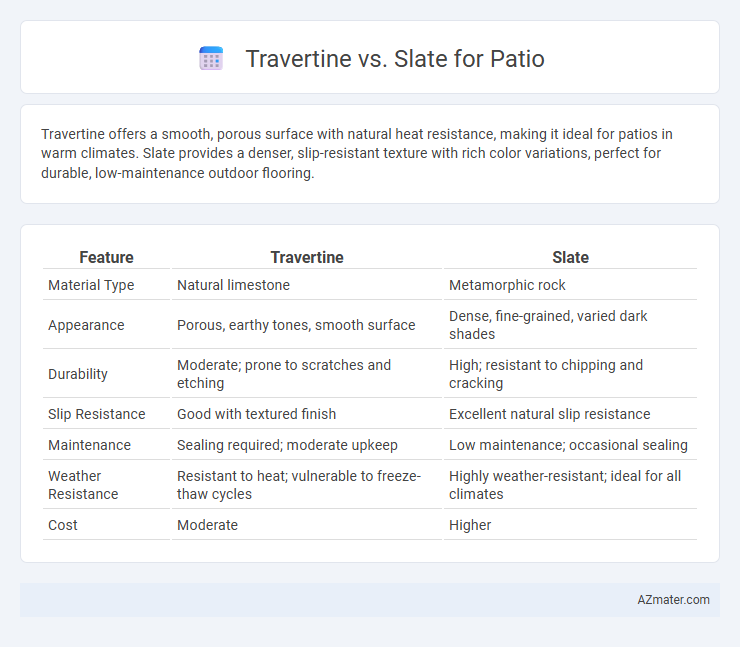Travertine offers a smooth, porous surface with natural heat resistance, making it ideal for patios in warm climates. Slate provides a denser, slip-resistant texture with rich color variations, perfect for durable, low-maintenance outdoor flooring.
Table of Comparison
| Feature | Travertine | Slate |
|---|---|---|
| Material Type | Natural limestone | Metamorphic rock |
| Appearance | Porous, earthy tones, smooth surface | Dense, fine-grained, varied dark shades |
| Durability | Moderate; prone to scratches and etching | High; resistant to chipping and cracking |
| Slip Resistance | Good with textured finish | Excellent natural slip resistance |
| Maintenance | Sealing required; moderate upkeep | Low maintenance; occasional sealing |
| Weather Resistance | Resistant to heat; vulnerable to freeze-thaw cycles | Highly weather-resistant; ideal for all climates |
| Cost | Moderate | Higher |
Introduction to Travertine and Slate Patios
Travertine patios offer a natural, warm appearance with porous stone that provides excellent heat resistance, making it ideal for outdoor spaces in hot climates. Slate patios are known for their durability and resistance to weathering, featuring a dense, non-porous surface with a rich color palette that enhances landscaping aesthetics. Both materials provide unique textures and long-lasting performance, with travertine delivering a softer, more natural look and slate offering a sleek, sophisticated finish.
Key Differences Between Travertine and Slate
Travertine, a natural limestone with a porous surface and light, earthy tones, offers superior heat resistance and a smooth texture ideal for patios in warm climates. Slate, a metamorphic rock, features a dense structure, rich dark colors, and better slip resistance due to its natural cleft surface, making it more durable in wet or cold environments. Key differences include travertine's softer, more uniform appearance and warmth, while slate provides a harder, more varied texture and enhanced durability against weathering.
Appearance and Color Variations
Travertine patios showcase a natural, warm palette with earthy tones like beige, cream, and light brown, featuring a porous, textured surface that adds rustic charm. Slate offers a dramatic range of colors including deep grays, greens, blues, and purples, with a smooth, layered texture that creates a sleek, contemporary look. Both materials provide distinct aesthetic benefits, making travertine ideal for classic designs and slate suited for bold, modern patios.
Durability and Longevity
Travertine offers high durability with natural resistance to cracking and fading, making it ideal for patios in climates with temperature fluctuations. Slate boasts exceptional longevity due to its dense, non-porous composition that withstands heavy foot traffic and weathering without significant wear. Both materials provide strong durability, but slate typically outlasts travertine in harsh environmental conditions.
Slip Resistance and Safety
Travertine offers excellent slip resistance for patios due to its naturally porous surface, reducing the risk of slips and falls even when wet. Slate provides a textured, non-slip surface that performs well in safety but can become slippery if polished or wet. For optimal patio safety, choosing unpolished, textured travertine or slate enhances traction and minimizes hazards.
Maintenance Requirements
Travertine patios require regular sealing every 1-2 years to prevent staining and weather damage, making upkeep moderately demanding. Slate patios offer greater durability with less frequent sealing needed, often every 3-5 years, and boast superior resistance to mold and mildew. Both materials benefit from routine cleaning, but slate's natural hardness typically results in lower maintenance over time.
Installation Process and Complexity
Travertine patios require careful cutting and sealing due to the stone's porous nature, which demands precise handling to prevent damage and staining during installation. Slate, being denser and less porous, offers a more straightforward installation with fewer concerns about sealing, but its natural cleft surface may require additional leveling and grinding to achieve a smooth finish. Both materials typically need a solid sub-base and professional expertise to ensure durability and aesthetic appeal, with travertine installations often considered more complex due to the stone's delicate texture and weight.
Cost Comparison: Travertine vs Slate
Travertine patios generally cost between $15 to $30 per square foot, offering a more affordable option compared to slate, which ranges from $20 to $40 per square foot. Installation costs for travertine typically run lower due to its lighter weight and easier cutting characteristics, while slate's dense composition often demands more labor and specialized tools, increasing overall expenses. Maintenance costs also differ; travertine requires periodic sealing but is less prone to chipping, whereas slate may incur higher upkeep due to its susceptibility to scratching and moisture absorption.
Climate Suitability and Weather Resistance
Travertine patios excel in warm, dry climates due to their porous structure, which provides natural cooling underfoot while maintaining durability against UV exposure and moderate moisture. Slate performs better in regions with frequent rain or freeze-thaw cycles, offering superior water resistance and slip resistance thanks to its dense, non-porous composition. Both materials withstand weather extremes but choosing travertine or slate depends on specific climate factors such as humidity levels, rainfall frequency, and temperature fluctuations.
Choosing the Right Stone for Your Patio
Travertine offers a smooth, warm surface with natural pores that provide excellent slip resistance, making it ideal for poolside patios and hot climates. Slate, known for its rich colors and textured finish, is highly durable and weather-resistant, perfect for patios exposed to heavy foot traffic and variable weather conditions. Choosing between travertine and slate depends on your climate, aesthetic preference, and the required maintenance level for long-lasting patio beauty.

Infographic: Travertine vs Slate for Patio
 azmater.com
azmater.com